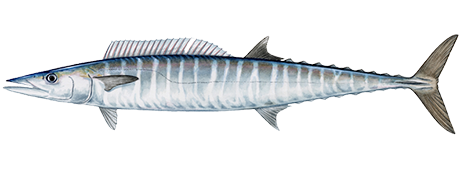
Wahoo
<p>The wahoo is reputed to be one of the fastest fish in the sea, attaining speeds of 50 mph (80 km) and more.</p>

Region
South
Catch ease
Hard
Habitat
Ocean
HOW TO IDENTIFY A WAHOO
The upper jaw is movable and the teeth are large, strong, and laterally compressed. The well defined lateral line dips noticeably near the middle of the first dorsal fin, further forward than on the similar looking tanguigue (Scomberomorus commerson), and is wavy back at the tail. The back is a brilliant, deep blue sometimes described as metallic or electric blue. Bright blue vertical bands, or tiger stripes, flow down the sides into silver and sometimes join into parts of the belly. Those stripes are not always prominent in large specimens and, occasionally, may be missing entirely.
WHERE TO CATCH WAHOO
Wahoo are found worldwide in tropical and temperate seas. Pelagic and seasonally migratory, it tends to live a solitary life or travel in small groups of 2 to 6 fish. There are indications of seasonal concentrations off both the Pacific and Atlantic coasts. They are found around wrecks and reefs that hold smaller fish that it feeds upon, but they may be found far out at sea. The following list includes additional details on where to catch this fish:
How to catch Wahoo
The first scorching run may peel off several hundred yards of line in seconds. Occasionally this fish jumps on the strike and often shakes its head violently when hooked in an effort to free itself. Fishing methods include trolling with whole, rigged baits as well as with strip baits or artificial lures. Live bait fishing is productive, but the wahoo is a relatively scarce species and is usually taken incidentally while fishing for other oceanic species. The following are fishing methods used to catch this fish:
Wahoo lures, tackle & bait
The following are lures, tackle or bait that can be used to catch this fish:
